Highlighted Publications
A full list of publications is available on the NIEHS website.
 Bound and Unbound: Seeking to Understand PFAS in the Bloodstream - PFAS binds to blood serum proteins and impacts protein accumulation, circulatory distribution, and elimination. The unbound portion of PFAS, untouchable by biomolecules, can be transported to organs and recirculated in the bloodstream, and therefore more likely to elicit toxic effects. In a recent study, STEEP researchers investigated the competitive binding of PFAS to two major… ...Read more
Bound and Unbound: Seeking to Understand PFAS in the Bloodstream - PFAS binds to blood serum proteins and impacts protein accumulation, circulatory distribution, and elimination. The unbound portion of PFAS, untouchable by biomolecules, can be transported to organs and recirculated in the bloodstream, and therefore more likely to elicit toxic effects. In a recent study, STEEP researchers investigated the competitive binding of PFAS to two major… ...Read more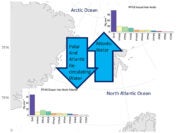 STEEP Researchers Track PFAS, Circulating, Cycling Worldwide - Evidence suggests PFAS in the remote northern hemisphere are the result of long-range transport in the air and ocean. STEEP researchers deployed passive samplers in the Fram Strait, a passage of water between Greenland and the Norwegian archipelago of Svalbard, with aims to understand PFAS there and assess if sources of PFAS are changing. Yes…and?… ...Read more
STEEP Researchers Track PFAS, Circulating, Cycling Worldwide - Evidence suggests PFAS in the remote northern hemisphere are the result of long-range transport in the air and ocean. STEEP researchers deployed passive samplers in the Fram Strait, a passage of water between Greenland and the Norwegian archipelago of Svalbard, with aims to understand PFAS there and assess if sources of PFAS are changing. Yes…and?… ...Read more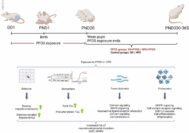 Combined with High-Fat Diet, PFOS Exposure Impacts Neurodevelopment in Mice - PFOS can affect several brain functions including memory, coordination, and social activity. Similarly, diets high in fat can impair cognition and increase risk for dementia. A study from STEEP researchers explores the relationship between PFOS exposure and a high-fat diet, demonstrating that the combination promotes repetitive behavior, hyperactivity and social withdrawal in mice. ...Read more
Combined with High-Fat Diet, PFOS Exposure Impacts Neurodevelopment in Mice - PFOS can affect several brain functions including memory, coordination, and social activity. Similarly, diets high in fat can impair cognition and increase risk for dementia. A study from STEEP researchers explores the relationship between PFOS exposure and a high-fat diet, demonstrating that the combination promotes repetitive behavior, hyperactivity and social withdrawal in mice. ...Read more Mobile-Laboratory Experiments Assess PFAS in Fish, Mussels on Cape Cod - Aqueous film-forming foams (AFFF) were historically deployed for fire department training activities on Joint Base, Cape Cod, Massachusetts, and resulted in extensive groundwater PFAS contamination. In this study from STEEP researchers, PFAS concentrations in aquatic species, water, and samplers, a result of groundwater discharging to surface waters, were evaluated in mobile-laboratory experiments. ...Read more
Mobile-Laboratory Experiments Assess PFAS in Fish, Mussels on Cape Cod - Aqueous film-forming foams (AFFF) were historically deployed for fire department training activities on Joint Base, Cape Cod, Massachusetts, and resulted in extensive groundwater PFAS contamination. In this study from STEEP researchers, PFAS concentrations in aquatic species, water, and samplers, a result of groundwater discharging to surface waters, were evaluated in mobile-laboratory experiments. ...Read more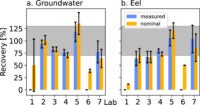 PFAS in Groundwater and Eel Emphasize Need for Standards - STEEP researchers collaborated with seven independent, international laboratories, representing academic, government, and commercial organizations, to compare extractable organoflourine and targeted PFAS measurements in groundwater and eel (Anguilla rostrata) from sites contaminated with fire-fighting foam. Overall, the comparison underscores the need for standard methods for sample extraction, instrumental analysis, and data processing. ...Read more
PFAS in Groundwater and Eel Emphasize Need for Standards - STEEP researchers collaborated with seven independent, international laboratories, representing academic, government, and commercial organizations, to compare extractable organoflourine and targeted PFAS measurements in groundwater and eel (Anguilla rostrata) from sites contaminated with fire-fighting foam. Overall, the comparison underscores the need for standard methods for sample extraction, instrumental analysis, and data processing. ...Read more STEEP Researchers Find Small RI River May Pose a Big PFAS Problem - In research, textiles and PFAS have long been intertwined. Yet the public understanding of this connection is less obvious, even more so considering that river-side textile mills have existed far longer than our knowledge of PFAS. A recent study by STEEP researchers suggests that both active and shuttered textile mills along a small river in… ...Read more
STEEP Researchers Find Small RI River May Pose a Big PFAS Problem - In research, textiles and PFAS have long been intertwined. Yet the public understanding of this connection is less obvious, even more so considering that river-side textile mills have existed far longer than our knowledge of PFAS. A recent study by STEEP researchers suggests that both active and shuttered textile mills along a small river in… ...Read more Evaluating full environmental impacts of “low concern” polymeric PFAS - A recent op-ed from STEEP Director Rainer Lohmann, PhD, and Robert Letcher, National Wildlife Research Centre, Ontario, details the current state of research on fluorinated polymeric PFAS, their uses, chemical properties, and concerns surrounding their environmental and human health impacts ...Read more
Evaluating full environmental impacts of “low concern” polymeric PFAS - A recent op-ed from STEEP Director Rainer Lohmann, PhD, and Robert Letcher, National Wildlife Research Centre, Ontario, details the current state of research on fluorinated polymeric PFAS, their uses, chemical properties, and concerns surrounding their environmental and human health impacts ...Read more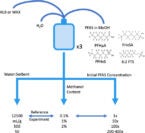 Easy to introduce, hard to remove…STEEP researchers hone methods for PFAS measurement and treatment - STEEP researchers in the University of Rhode Island Lohmann Lab are focusing their efforts on developing accurate and effective methods for measuring, sampling, and treating PFAS in the environment. ...Read more
Easy to introduce, hard to remove…STEEP researchers hone methods for PFAS measurement and treatment - STEEP researchers in the University of Rhode Island Lohmann Lab are focusing their efforts on developing accurate and effective methods for measuring, sampling, and treating PFAS in the environment. ...Read more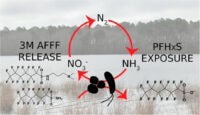 Microbial superpowers: environmental bacteria can transform precursor PFAS in AFFF-contaminated sites - Microorganisms can break down many natural and anthropogenic substances, including industrial pollutants, like oil, plastics, and even PFAS. STEEP researchers found that microbes in lake sediments and groundwater may be able to convert precursor PFAS molecules into terminal compounds at an AFFF-contaminated site. ...Read more
Microbial superpowers: environmental bacteria can transform precursor PFAS in AFFF-contaminated sites - Microorganisms can break down many natural and anthropogenic substances, including industrial pollutants, like oil, plastics, and even PFAS. STEEP researchers found that microbes in lake sediments and groundwater may be able to convert precursor PFAS molecules into terminal compounds at an AFFF-contaminated site. ...Read more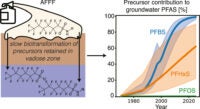 Forget diamonds…PFAS are forever: STEEP researchers conclude PFAS may linger in groundwater for centuries - Model results demonstrated that precursors in remaining PFAS at AFFF-contaminated sites accounted for an average of 46% of the total PFAS in groundwater, but their contribution increases over time and these chemicals can persist in the environment for centuries ...Read more
Forget diamonds…PFAS are forever: STEEP researchers conclude PFAS may linger in groundwater for centuries - Model results demonstrated that precursors in remaining PFAS at AFFF-contaminated sites accounted for an average of 46% of the total PFAS in groundwater, but their contribution increases over time and these chemicals can persist in the environment for centuries ...Read more PFAS exposure associated with weight loss relapse in a European dietary study - Many factors contribute to obesity, though there is gathering evidence that exposure to environmental toxins, such as PFAS, could be contributing to the obesity epidemic. A recent study tested whether PFAS has an effect on body weight increases in an already-established dietary intervention study. They found that certain types of PFAS are associated with increased… ...Read more
PFAS exposure associated with weight loss relapse in a European dietary study - Many factors contribute to obesity, though there is gathering evidence that exposure to environmental toxins, such as PFAS, could be contributing to the obesity epidemic. A recent study tested whether PFAS has an effect on body weight increases in an already-established dietary intervention study. They found that certain types of PFAS are associated with increased… ...Read more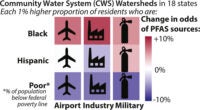 Analysis finds marginalized communities disproportionately affected by PFAS - Environmental hazards are disproportionately placed near marginalized communities, and the factors underlying this issue are multifaceted and systemic. A recent study published by STEEP researchers in the Harvard University Sunderland Lab is the first to evaluate the effects of PFAS on communities in the context of environmental justice ...Read more
Analysis finds marginalized communities disproportionately affected by PFAS - Environmental hazards are disproportionately placed near marginalized communities, and the factors underlying this issue are multifaceted and systemic. A recent study published by STEEP researchers in the Harvard University Sunderland Lab is the first to evaluate the effects of PFAS on communities in the context of environmental justice ...Read more

